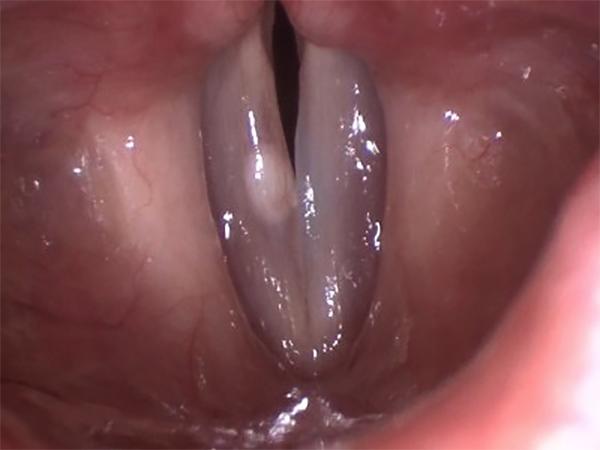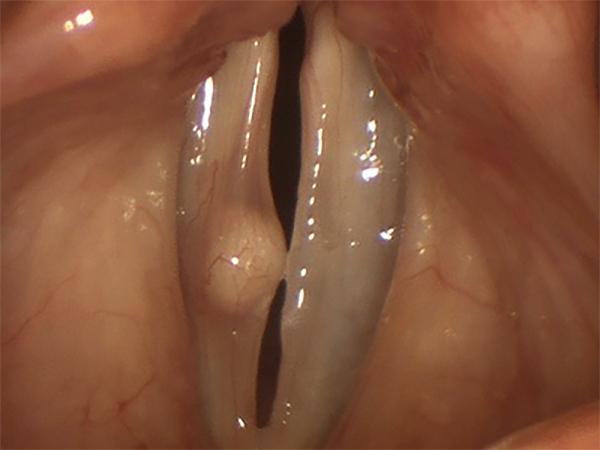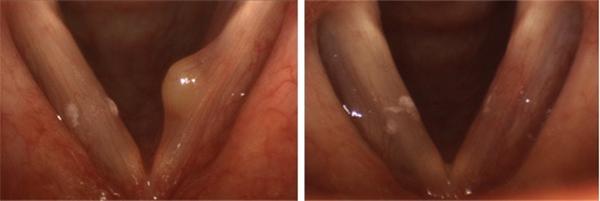Whether you see us in-person or by Video Visit, we're here for you. See how we're keeping you safe.
A cyst is a mass made up of a collection of material, usually mucus, that is surrounded by a membrane envelope. It is found underneath the epithelium, within the superficial lamina propria, the layer that is important for normal voice function. It is not entirely clear why cysts form, but many believe that they result from mucous glands that have become blocked. Sometimes, this happens spontaneously, but it seems likely that glands are more prone to become clogged when the vocal folds are irritated. Many cysts occur at the midpoint of the vocal fold, which suggests that phonotrauma, the physical stress resulting from voice use, may contribute to their formation. Cysts are not precancerous or cancerous lesions - they are important to recognize purely due to their effect on the voice.

An ovoid cyst is visible underneath the covering (“epithelium”) of the vocal fold.

A large mid-vocal fold cyst interferes with vocal fold closure and vibration during voicing.
Cysts generally cause painless hoarseness. The hoarseness results from irregularities in vocal fold closure and vibration, both based on the bulk and location of the cyst. In some cases, the voice change may be accompanied by a sensation of a foreign body at the level of the vocal folds, or a feeling of wanting to clear the throat or cough. Hoarseness resulting from the presence of a vocal fold cyst tends to be chronic and stable rather than progressive or fluctuating.
A cyst is usually a spherical or egg-shaped (ovoid) white or translucent mass located underneath the epithelium (cover) of the vocal fold. Because the epithelium drapes over it, it may look like a mound within the fold. For this reason, very small cysts may be indistinct. Cysts are typically found on one vocal fold only. Although they may appear anywhere along the length of the vocal fold, a mid-fold location is most common. Examination by stroboscopy and under magnification is helpful in clarifying the diagnosis.

These images show the appearance of the vocal folds before (left) and 10 days after (right) surgical removal of a vocal fold cyst. Removal of the cyst has restored the normal contour and function of the vocal fold.
Voice rest, often prescribed in cases of hoarseness, may improve but not cure the condition. Voice rest serves to soften and dissolve associated swelling, but the cyst itself will not usually shrink.
Very rarely, a cyst may resolve on its own, usually due to a resolution of the blockage that led to the accumulation of fluid, allowing the cyst to drain. This generally happens only when a cyst has been present for a short while, and even under these circumstances, it is unusual. Most commonly, a cyst must be removed surgically by means of microlaryngoscopic surgery. Because incomplete removal may lead to recurrence, every effort must be made to remove the cyst intact. At the same time, the overlying layer must be preserved and draped over the area where the cyst was removed to minimize the chance of scar. This type of surgery, commonly called a “microflap approach”, is technically challenging because the cyst, which is usually fragile, may be attached to surrounding tissue and is likely to burst or leak, even when handled carefully.